How UGC Can Radically Enhance the Ecommerce Shopping Experience

The first use case of UGC was taken to collect information for the Oxford English Dictionary – as written in Simon Winchester’s The Meaning of Everything.
User-generated content is omnipresent in different forms and continuously affecting our decisions and psychology. The influence can be understood from a quote by Andy Crestodina.
“When you say it, it’s marketing; when your customers say it, It’s Social Proof.“
Rightly so, as social proof is the key to achieving more online sales and success.
The ecommerce ecosystem is expanding rapidly among all markets globally. The opportunities are also expanding for ecommerce brands; still, these brands struggle with major issues like brand trust, loyalty, cart abandonment, and conversion rate.
Consumers have become highly selective in their buying decisions and look for content that delivers necessary information, trust signals, and authenticity.
Branded content isn’t trustworthy, neutral, and authentic – it’s a well-known fact. Now here comes the role of User-generated content for ecommerce brands and its impact on shopping experiences.
So, what is UGC? How does it influence ecommerce? and what you must do to leverage users’ content on your ecommerce site.
What Is User-Generated Content?
User-generated content (or consumer-generated content) is the content that customers or social media users have shared based on their experiences, opinions, and decisions, mainly about brands or its products/services.

The user-generated content includes images, videos, ratings, reviews, gifs, audio, etc. – all forms of content that the users have shared.
UGC is popular as the most reliable, trustworthy, authentic, realistic, and insightful content driven by the consumer experience. Thus, it shows the real value and real-life experiences of a brand’s customers.
This is what ecommerce brands need from their content – Trust, Information, and authenticity.
So, the integration of user-generated content on ecommerce platforms is the best marketing strategy for ecommerce brands to turn their struggles into success.
Why is UGC Effective?
90% of the consumers believe user-generated content is more influential on their buying decisions as compared to the promotional branded content. Similarly, 2/3rd of the users believe UGC creates a more trustworthy and authentic shopping experience.
UGC can help the ecommerce sites develop a sense of authenticity and build trust among the customers towards the brand. It also helps create a closer relationship with the customers.
Visual content plays an important role in ecommerce sites, especially when it comes to product photos and videos. Now, branded visual content isn’t as effective – as it is one-dimensional promotional and boring photos.
However, user-generated content that features products is way more exciting, realistic, and creative. It gives an appealing view of products being used in real-life by real customers.
Along with this, the most common form of UGC, i.e. reviews and ratings, have been the key for ecommerce brands as they are quantitative and qualitative metrics about a products/service quality, value, worth, reliability, etc.
UGC + Ecommerce: 3 Types of UGC Fit For Your Online Store
User-generated content has different forms, shapes, intent, and styles but it is essential to identify which type of UGC will align with your online store to gain maximum returns through the UGC campaign
1. Reviews and ratings by customers.
In 1999, websites like eBay, Epinions, Deja and RateItAll allowed customers to write their feedback and reviews about their experience with the brand. That is how social reviews made the appearance.
Customer reviews help the ecommerce business show the world how credible they are and help them ensure customer satisfaction.
These reviews are valuable assets that help the brand analyze if their products and services are fulfilling the customers’ needs. If not, then with the help of UGC, they can analyze experiences and make the necessary changes and can also acquire new customers.
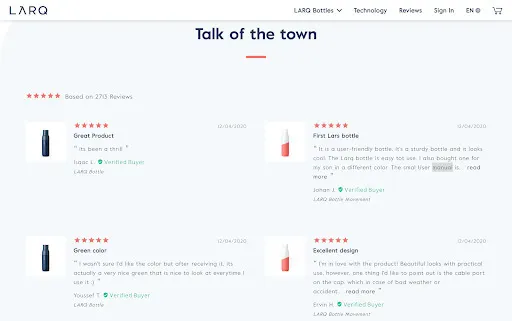
Not only sugar-coated and positive reviews, but even negative reviews help make a positive impact for the brand to grow organically.
Solo Stove is a great example of this. Its website allows fans to submit stories about their camping trips and other experiences with their products so other potential customers can see the product in action.
Do not restrict yourself from sharing user-generated content just on your ecommerce website. You can put these reviews, images, social posts shared by customers on your official website and across social media networks to enhance user-engagement.
Users will always embrace other customers’ opinions and find their word credible over the advertising by the brand. Including customer reviews in your ad campaign can improve the chances of fetching new audiences.
Testimonials given by the customers on ecommerce websites can improve the product’s image and make it more genuine. Use them to create alluring banners and advertisement campaigns that will push the customers to share their feedback on social media sites.
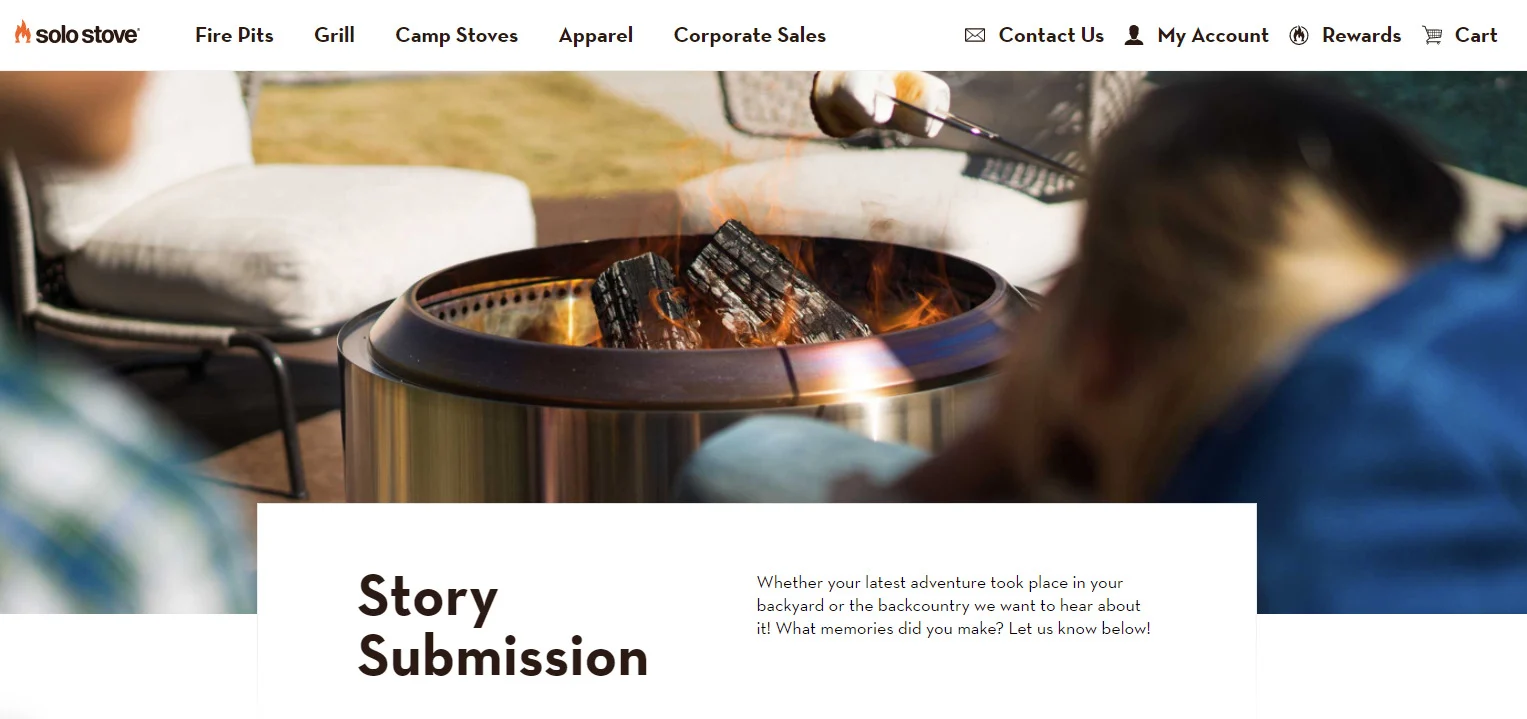
If the UGC is qualitative and impactful, it can increase the conversions and scale your ROI in the long run. Investing in UGC can transform the brand image and enhance its social presence.
2. Instagram’s visual UGC.
Instagram is the most popular social media platform – be it for the brands or the users. The reasons for this manifold where Instagram is making efforts to fulfil both consumers and brands’ needs.
Having 1.16 billion users in Q3 2020, Instagram has seen rapid growth in its active users. Moreover, the rising popularity of branded hashtags has led to Instagram becoming a hub of user-generated content.
Ecommerce brands and brands from the hospitality industry are leveraging Instagram UGC in their marketing campaigns.
Ecommerce brands have a huge potential as users are leveraging Instagram posts to discover products/brands, find inspiration, and shop for the products/services. The credibility to the earlier statement is given by the fact that over 130 millions users click on shoppable Instagram posts.
What is more mesmerizing is that 81% of these users search for products and services on Instagram. Simultaneously,50% of all people surveyed in the UK, France, and Germany have once visited a website after discovering a product/service on Instagram.
A growing trend among ecommerce is to create Shoppable Instagram and UGC feeds and publish them on their online store using a platform like Taggbox Commerce. These shoppable galleries work as inspiration for consumers to shop the look.
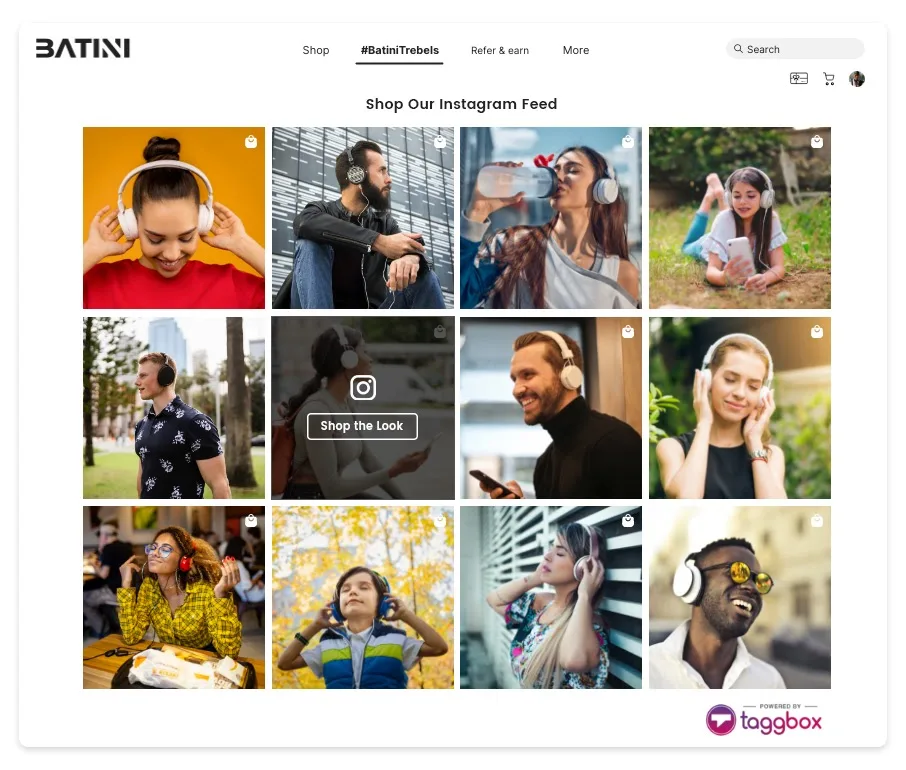
When you leverage UGC on Instagram, ads, or an online store, it is acquired legally with permissions. Also, make sure to filter and utilize the most engaging, appealing, and insightful UGC.
2. Posts from social platforms.
Besides Instagram, numerous social media platforms have billions of active users constantly uploading content in different forms like images, texts, micro-blogs, audio content, and more.
It’s not just Instagram that is beneficial for ecommerce and online stores; rather, social platforms like Facebook, Twitter, YouTube, Snapchat, Tumblr, etc., also offer growth prospects.
People love to share their experiences and opinions on Twitter in relevance to the brands and their products/services. They love posting snaps about their lifestyle on snapchat.
Facebook shopping is also becoming a trend since the inception of Facebook shops. Facebook is still a popular social platform with the most diverse user-generated content forms, including videos, images, stories, texts, audios, and more.
Skullcandy, a leading global brand in music accessories, implemented the Facebook shop feature by BigCommerce to reach the consumers and deliver a more seamless and quicker shopping experience through social media networks.
About videos, well! There are different platforms with different video content styles. YouTube majorly features unique user-generated content as video reviews, vlogs, etc. Whereas TikTok is a short-video user-generated content-driven platform.
With their unique content types, all these social media platforms feature user-generated content that is highly valuable for ecommerce brands.
Besides, Twitter reviews and Facebook reviews work as social proof for online stores to build authenticity, reliability, and trustworthiness.
Why Do You Need UGC For Your Ecommerce Store?
Explore a few of the many reasons why you must integrate the all-valuable user-generated content with your online store. UGC helps you tick all the boxes of your ecommerce marketing goals. Here’s how:
1. Increases your ecommerce conversions.
The superpower of users’ content is that it can be integrated anywhere in the ecommerce sales funnel – be it at the awareness stage, consideration stage, or decisions stage. UGC creates a complete journey to drive users towards a successful conversion.
One of the major reasons UGC is so highly influential on ecommerce conversions is that it is the most trustworthy, reliable, and authentic content in the marketing ecosystem.
Consumers look for trust signals while making online purchases, and UGC provides that perfectly with real information from real customers about the products/services. Consumers featuring user-generated content, be it reviews or visuals, can help consumers understand your brand’s credibility and explore customer experiences.
If you share user-generated content that talks positively about your brand, you can turn it into an inspiration for driving sales. You can even turn your UGC into a shoppable UGC gallery and allow customers to “shop the look” as seen in the UGC gallery.
9 out of 10 people surveyed found consumer-generated content influential when they intend to make an online purchase. UGC has an immense influence on the buying decisions of customers. Be it any form of user-generated content like reviews, ratings, images, or videos – all of it can attract and influence the ecommerce audience to buy products.
2. Build brand awareness and user-engagement.
Although the major goal is to increase ecommerce conversions, that isn’t possible if the user does not know about you or doesn’t engage/interact with your platform.
In a consumer buying journey, brand awareness is the first and foremost step. If people do not know about your ecommerce brand, there isn’t even a chance to get conversions and acquire customers.
User-generated content gives a perfect platform to build awareness about your ecommerce store. Social media is a UGC hub, and billions of people explore products, gain awareness, and gather information about new products and brands through user recommendations, customer reviews, visual UGC relating to the brand.
Building awareness leads to driving potential customers towards engagement with your brand. And engagement is undeniably a major objective of ecommerce marketing strategy as it is positively correlated to conversions.
Engagement of users with an ecommerce platform means the user intends to access information, make comparisons, and review customer experiences to form an informed buying decision.
Therefore, to drive maximum user engagement, you need to have fresh, original, valuable, and authentic informative content. User-generated content checks all the aforementioned necessary characteristics.
The integration of user-generated content with ecommerce becomes even more essential to sell the products/services as potential customers want to explore first what other customers are saying and their experiences.
So, to increase your ecommerce platform engagement, you must showcase visual UGC and customer reviews or ratings.
3. Enhance customer shopping experience.
Consumers highly value their shopping experience – be it an online experience or the offline real-life shopping experience. Any shortcomings or negative experiences can lead to a loss of potential customers.
However, delivering a seamless and exciting shopping experience digitally is a humongous challenge as consumer emotions can not be studied, unlike offline experiences.
User-generated content can be an excellent solution to building a unique digital shopping experience. Customer reviews on your ecommerce site provide a detailed and measurable quality metric for potential customers.
Will displaying UGC galleries on ecommerce work as inspiration for consumers who want to explore how the product would look in real life? How are other customers using it? Possibilities of that product, etc. Even further, making the UGC shoppable will help in turning users’ inspiration into conversions.
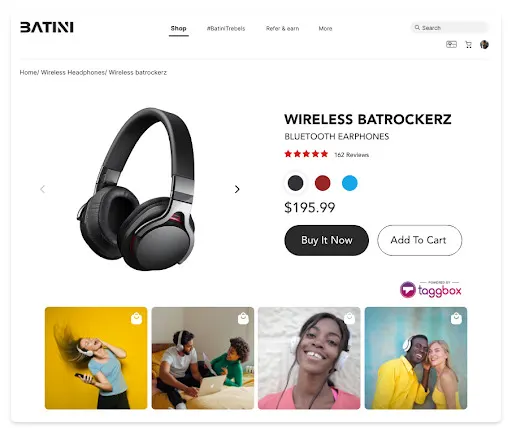
The buying journey will become more seamless, quicker, and insightful, where users can explore, evaluate, get inspired, and buy the products instantly without any break inexperience.
4. Humanize rather than marketing.
Gone are the days when marketing was all that was needed to sell your products and increase your revenue. But the time has evolved, and consumers have evolved with time.
Nowadays, consumers can easily differentiate between branded advertising and authentic information sharing. Retailers need to take a humanized approach to promote authenticity and reliable information about their brand and its products/services.
Unlike other forms of content, consumer-generated content builds a direct relationship with the customers. Created by users themselves, consumer-generated content humanizes a brand in the most simple yet unique way.
But how can UGC humanize your ecommerce campaigns?
The existing customers share User-generated content, so UGC campaigns will help connect better with potential consumers. They can easily relate to the thoughts of other customers.
Also, UGC helps in showcasing the community of a brand to potential users. Consumers can resonate with UGC as it shows better relevancy, humanized emotions of existing customers, and their real experiences – making your campaigns more “HUMANE”.
In short, humanizing a brand boosts its value in the market and grabs the attention of the customers.
5. Builds content in your library.
Content is a key component of an ecommerce platform as this will engage and convert the leads into customers. The content on your ecommerce platform needs to be planned and created for the consumers and not your marketing purposes.
Creating content is a tremendous task that requires regular investments into research, resources, time, and content creators. Moreover, content creation is a consistent process requiring consistent expenses.
The best alternative to branded content is – user-generated content. Social media is a hub of users’ content. With platforms like Taggbox, you can easily collect, curate, customize, and publish UGC on your ecommerce website.
Having UGC at your disposal helps you reduce content creation costs like product images and videos for your ecommerce platform.
The UGC is like a stream that flows continuously to give you new, fresh, original, and valuable content for your UGC campaigns. You can collect all your valuable content and build a UGC hub for your campaigns. The best part is UGC campaigns work like a chain reaction where they help in generating more user-generated content for your brand.
6. Inspires brand loyalty.
Aggregating the relevant and qualitative UGC from various social networks is termed social proof. It is credibility provided by the consumers about a brand’s authenticity, reliability, and trustworthiness.
Social proof like testimonials, product images, selfies and videos shared by the users is the effective marketing strategy to attain more audience.
People will follow the customer’s feedback and not branded content. Also, it develops the trustworthiness of the brand in the new users and retains loyal customers.
Brand loyalty is priceless in this competitive ecommerce ecosystem. This makes user-generated content even more valuable than it already is. Those customers who share positive content about your brand publicly are your brand fans. These people are more likely to make repeat purchases with your brand.
The content shared by loyal fans can include product reviews, testimonials, satisfying customer experiences, product images or videos that showcase your brand’s premium quality, value for money, and happy customers.
This type of content attracts new customers and creates a desire to be associated with your brand. Building initial brand image and delivering satisfying experiences leads to fostering brand loyalty, community-creation, and maximum customer lifetime value.
Promoting user-generated content also highlights the transparency and confidence of a brand in its customers. This way, UGC inspires brand loyalty by showing how highly you value your customers.
Example of an Ecommerce Stores Using UGC to Their Advantage
1. SkullCandy.
Skullcandy has a creative content marketing strategy on their BigCommerce website. Their marketing strategy revolves around creating content with high visual appeal, subtle product display, and showcasing experiences and ideas.
Along with creative branded content features, the customer reviews – a necessary form of user-generated content essential to help increase conversions.
Customer reviews have existed for a long time on ecommerce websites, and they are getting more important than ever. No matter how exciting and engaging your brand campaigns are, UGC like customer reviews are important to turn a consumer into a customer on ecommerce.
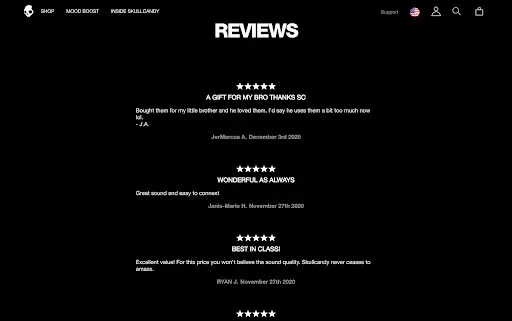
Skullcandy has included these customer reviews on their product pages. The flow of content from top to bottom, starting from product images to its key features and summing it by social proof through reviews, helps consumers make an informed decision.
How Can You Leverage UGC For Your Online Store?
An amazing part about UGC is that it is not restricted to any particular brand or any industry. One of the few restrictions around UGC comes from the customer experience that you provide to your users.
UGC works the same as Karma; you get what you give.
The other restriction is that you need to have a big enough customer base (who are satisfied with your services) to generate positive content based on their customer experiences.
Not millions or thousands, even hundreds of loyal customers, can generate enough UGC for your ecommerce to create and run UGC campaigns.
1. Analyze Your Audience.
The first step to leveraging UGC to enhance your ecommerce sales and experience is to analyze who your audience is, which digital content sharing platforms they use?
You will mostly find your audience on social media platforms, which is the best place to leverage user-generated content. Social media is the place where users can easily interact and engage with your brand.
Along with social media, you can even find opportunities on different platforms driven by user-generated content like Yelp, Google reviews, Airbnb reviews, etc.
2. Analyze your competitors and industry.
Competitors are great teachers too. If you have competitors or players from the industry who are also leveraging user-generated content, then you can take inspiration from them.
Find out how they have integrated UGC into their ecommerce marketing campaign. Learn how they are curating UGC from which platforms? What type of customers share content most regularly? What type of content is being leveraged by them and more.
3. Create your ecommerce UGC campaign.
Once you explore the market trends around UGC and where you can find UGC, then comes the time for you to create a UGC campaign.
First of all, if you don’t have UGC currently, then you can leverage different tactics to generate UGC, like running hashtag campaigns on social media and gamification campaigns that lure customers to engage and contribute content in return for rewards, gifts, vouchers, discounts or even the chance of featuring in your campaigns.
To get started with your UGC campaign, you can leverage a UGC platform like Taggbox, which will help you collect, curate, and publish UGC for your campaigns. Also, you can create direct submission channels like Passion Planner, where users can directly submit their content, be it reviews or visuals, to your platform.
Using a UGC platform is the best option. It single-handedly helps you create and publish UGC campaigns that save time and massive investments. You get complete solutions from collecting UGC from diverse platforms like social media, reviews platforms etc.
You can then customize the collected content with themes, layouts, designs, colours, and many more options to give a direction to the content and instil your campaign plan.
Furthermore, if you intend to make your UGC shoppable, you can tag products to the UGC gallery or even get the UGC rights directly from the users and leverage UGC without any restrictions.
Finally, publish your UGC campaigns on your ecommerce platform to build social proof, drive sales, and enhance the customer experience. The UGC can be leveraged on social media campaigns, emails, social ads, offline channels, and more to create a complete ecosystem.
Wrapping Up
User-generated content in all and any forms influences the consumers’ shopping psychology. This presents an immense opportunity for ecommerce brands to leverage UGC to enhance their ROI, growth, and shopping experience.
It is the perfect time to get started with UGC campaigns for your ecommerce brand. Take inspiration from the examples, review the benefits you can achieve, and build your ecommerce UGC campaign.

Prakash Rawat is a Digital Marketer at Tagshop, a UGC platform for brands to help them create, and publish user-generated content campaigns across different marketing channels like online stores, emails, and social ads. He holds in-depth knowledge in SEO and PPC campaigns. He is always looking for ways to expand brand presence and organically magnify the influence of marketing efforts.


